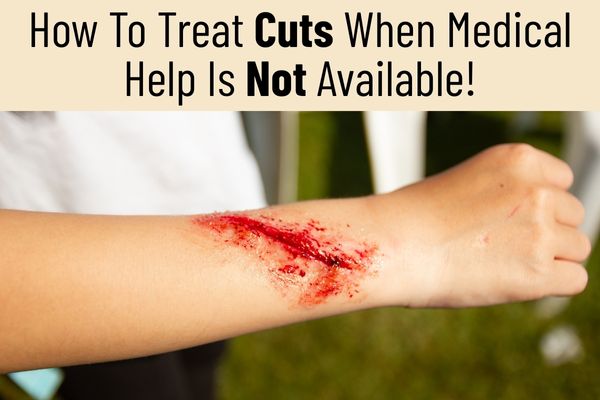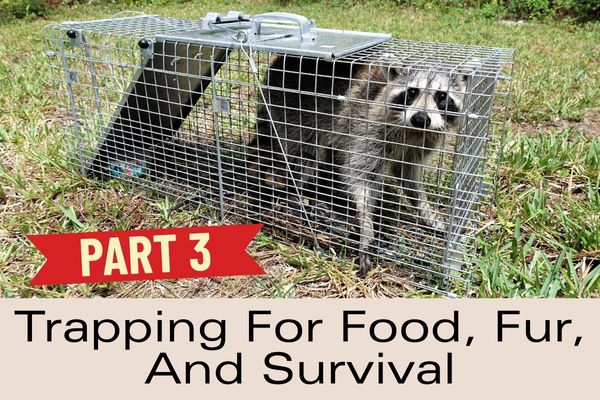Cuts Are A Common Injury … Treat Them Like A Pro
A smart prepper knows the importance of learning basic first aid as preparation for any emergency.
In some cases, the prepper will be fully equipped for a medical situation having a bugout bag full of first aid essentials. In other cases, a prepper may be caught in the wilderness, evacuating to safer ground without any first aid supplies.
And while having a comprehensive first aid kit is recommended, it won’t do you any good unless you take the time to gain first aid knowledge and wound-treating skills. You may think that a cut is such a common injury that it’s not worth your concern. But when improperly cared for, cuts can lead to infection, loss of blood, or worse.
Why Learning First Aid for Cuts Is So Important
When disaster strikes, there may be no access to a hospital, medical office, urgent care clinic, or 911 services. You would need to rely on your own prepper skills to administer first aid to yourself or anyone injured. Cuts that create bleeding and invite infection require immediate attention.
How to Treat a Cut
Minor cuts and scrapes are some of the most common injuries you’ll experience while bugging out. Whether it’s from tripping over a branch or brushing against sharp surfaces, these injuries are typically easy to treat. However, while they may seem minor, proper first aid is crucial to prevent infection and promote optimal healing.
Whether you cut yourself or you’re needed to treat a cut on another person, here are some basic steps to treat a cut.
Step 1: Quickly Assess the Situation
Quickly assess the situation and observe how shallow or deep the cut is. A shallow cut may only require basic first aid. A deeper cut may need more extensive treatment.
Step 2: Stop the Bleeding
No matter what causes a wound, implementing immediate first aid will make a big difference in how quickly you can stop the bleeding. As you’re assessing the wound, immediately take measures to control any bleeding. Apply gentle pressure using a clean bandage or cloth to help control the blood flow. Elevate the injured area above the heart to help minimize blood flow. If bleeding persists, maintain constant pressure until it slows.
Note: Though you want to stop blood flow, bleeding is one way nature devised to help clean the wound. But, of course, with bleeding too much will be problematic.
If the bleeding is severe find the pulse nearest the injury and apply pressure there. In worst case scenarios where the bleeding persists, make a tourniquet from a belt or scarf and place it between the injury and the heart and tie it tight to stop the blood flow.
Step 3: Clean the Wound
Before touching the wound, use soap and water to clean your hands to reduce the risk of introducing bacteria to the open wound. If you’re bugging out, you may have to rely on wound cleaning using natural resources and basic first aid supplies from your bugout bag.
Begin by rinsing the wound with clean water or saline solution to flush out dirt and debris using wound irrigation methods. Clean the wound carefully as every cut has the potential to become infected. Pat the area dry gently with a clean cloth.
If available, use a mild antiseptic to prevent infection. Avoid using harsh chemicals or rubbing the wound to avoid irritating the skin.
Step 4: Treat the Wound
When dealing with cuts and wound infections in the wilderness, make wound cleaning a priority to prevent complications. Apply an antibiotic ointment and cover the wound with a sterile dressing to prevent contamination. Utilize natural wound remedies like honey (a natural infection fighter) or aloe vera to aid in the healing process.
Apply an antiseptic ointment to the wound using a clean applicator or your fingers,. This helps prevent infection and supports the healing process. If the cut is deeper or caused by a dirty or rusty object, consider using antibiotic ointment to provide an extra layer of protection against infection.
Step 5: Bandage the Wound
After cleaning and applying an antibiotic ointment (if you have it), cover the wound with a Band-Aid, sterile bandage, or gauze, securing it with tape or clean fabric. To cover the wound, select an appropriate dressing based on the size and location of the cut.
Don’t secure the wound covering too tightly. You want the wound to breathe to aid proper healing. Assuming the bleeding has stopped or slowed down by this point, do not repeatedly remove the dressing to check on the cut. In doing so, you can disrupt the clotting process and reactivate the blood flow. (Change the bandage about once a day or when it becomes wet, dirty, or leaks fluids.)
Always remember to follow infection prevention protocols such as keeping the wound covered and sanitized in order to promote optimum healing.
Step 6: Monitor For Infection
Check the wound regularly for signs of infection. Watch for obvious physical changes as every cut, big or small, carries a risk for infection that can affect other areas of the body.
Signs of infection include:
:: Redness
:: Swelling
:: Excessive pain
:: Yellow or green discharge or pus
The infected person may start to feel nauseous, fatigued, or develop a fever. Consider the infected wound a serious situation. Seek medical intervention as soon as it becomes accessible.
If you’re nowhere near professional medical help and have no hope to get it, there are some steps you can take to treat the infection.
:: Soak the wound in hot water (or use hot compresses) for 20 – 30 minutes, 3 times daily (The heat will help bring infection-fighting white blood cells to the area.)
:: Open the wound to irrigate the infection
:: Cover the wound again
Step 7: Change the Dressing Regularly
Replace the bandage regularly, especially if the area becomes wet or dirty. It’s also important to change the dressing if the wound is excessively draining. Gently clean the wound again and reapply antiseptic ointment before putting on a new dressing. But do take care not to accidentally open the wound, disrupting the healing process.
What to Do if Deep Wounds Require Stitches When Bugging Out
In some cases, a deep cut might need stitches (suturing) and if you’re bugging out, you will not have immediate access to professional medical attention. In your bugout bag, it would be good for you to pack wound closure “butterfly” strips, wound closure tape, or tissue adhesive (skin glue) to create an alternative method to traditional stitches.
If those alternative (easier) methods are not adequate, purchase a “stitch kit” to keep in your bugout bag.
Here are steps to stitching a cut
:1: Disinfect the wound area
:2: Using a needle (preferably a curved shape) and thread, puncture the skin about ¼ inch from the edge of the wound
:3: Push straight through and exit out of the skin ¼ inch past the other side of the wound
:4: Continue the stitching until the wound is closed
:5: Tie a knot (square knot preferred) and cut the thread
Be sure not to make it too tight because you want to leave some space for the fluid to drain out to help reduce infection risks.
First Aid Treatment Supplies For Cuts
Consider these first aid supplies to treat cuts, scrapes, control bleeding, and help prevent wound infections:
:: Alcohol pads
:: Aloe Vera
:: Anti-bacterial wipes
:: Antibiotics ointment/Neosporin
:: Antiseptic wipes
:: Band-Aids/bandages
:: Blood clotting sponge
:: Butterfly bandages
:: Gauze pads
:: Gauze rolls
:: Hydrogen peroxide
:: Pressure dressing
:: Rolled gauze
:: Stitch kit
:: Surgical tape
:: Triangular bandages
:: Tourniquet
:: Wound closure strips
:: Wound irrigation syringe
Preppers Should Consider Getting a Tetanus Shot
When you’re bugging out, there may come a time when you step on a rusty nail or brush up against another un-sanitized area. You could then be faced with a tetanus-prone wound. Medical professionals suggest people get a tetanus booster shot every 10 years. Always seek the advice of a healthcare provider regarding whether a tetanus shot is recommended.
When Professional Help is the Only Treatment
There are those injuries that could be beyond basic first aid and demand medical treatment. When faced with a severe wound, recognize when professional help is necessary. Is there a prepper group nearby that has a doctor or a skilled medical professional? If it’s safe to do so, seek medical help.
Learn First Aid Skills Now So You Can Be Prepared And Confident
By following these first aid steps and adding wound-treating supplies to your bugout bag, you can confidently provide emergency first aid for cuts and scrapes.
First aid steps to remember:
:1: Quickly assess the situation
:2: Use pressure to stop the bleeding
:3: Clean the wound
:4: Treat the wound with an antibiotic ointment
:5: Bandage the wound
:6: Monitor for infection
:7: Change the dressing
Essential wound care may be critical when bugging out. Seek first aid training now so you can confidently administer treatment to cuts – or any injury – when called upon.




